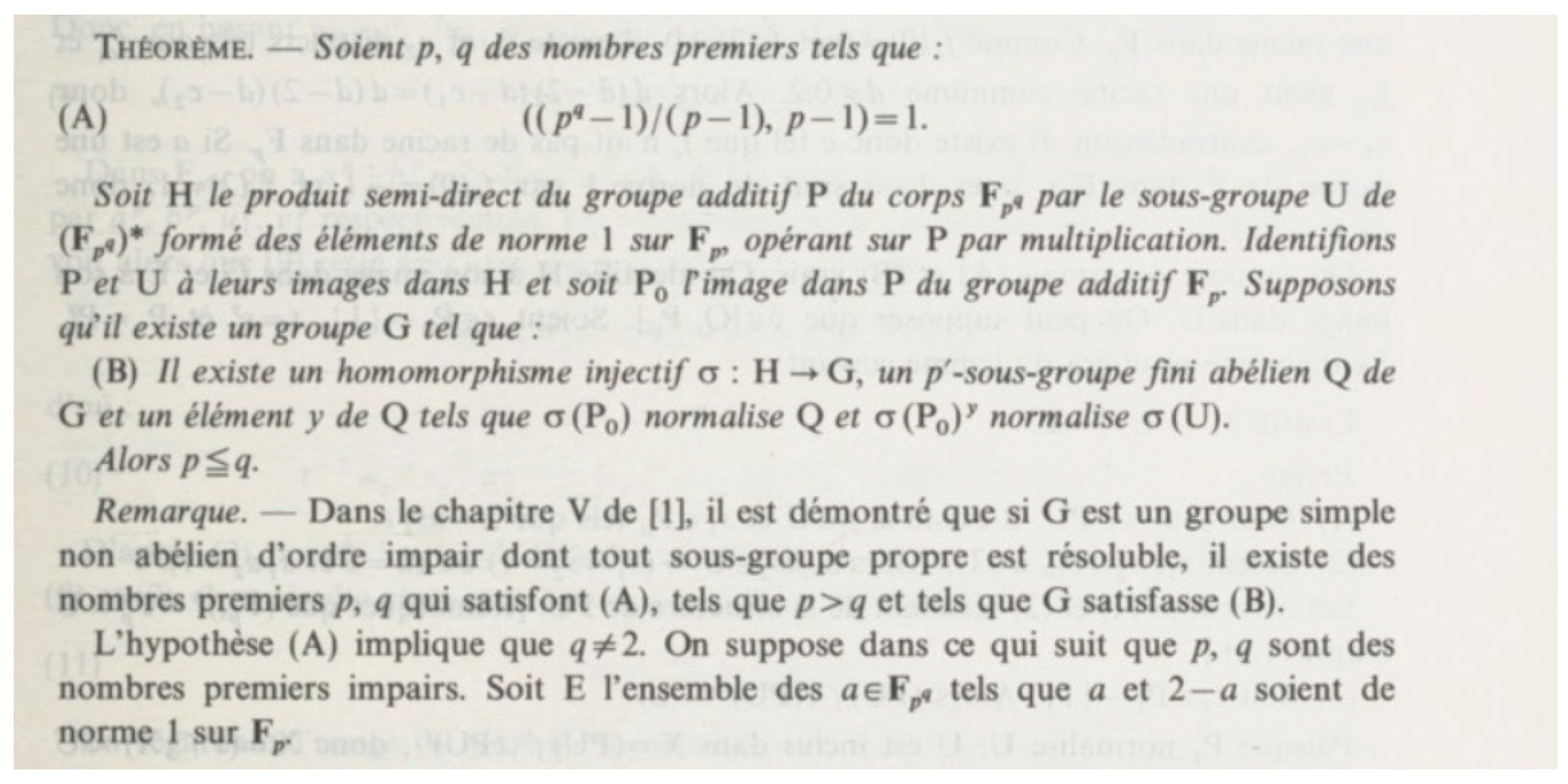Submitted:
20 March 2024
Posted:
21 March 2024
You are already at the latest version
Abstract
Keywords:
1. Introduction
2. Twin Primes
3. Contradictory Sources

4. Embedding our Result into the Scientific Literature
4.1. Auxiliary Result
4.2. Main Result and Proof
4.3. The Cases
5. Conclusion
Data Availability Statement
Conflicts of Interest
References
- OEIS, F. The On-Line Encyclopedia of Integer Sequences Entry A077800. https://oeis.org/A077800, 2024.
- Kaldwell, C. Are all primes (past 2 and 3) of the forms 6n+1 and 6n-1? https://t5k.org/notes/faq/six.html, 2021.
- Hua, L.K. Introduction to number theory; Springer Science & Business Media, 2012.
- Caldwell, C. The Prime Database. https://t5k.org/primes/page.php?id=122213.
- Dujella, A. Number theory; Školska knjiga Zagreb, 2021.
- Sono, K. Recent progress on twin prime conjecture. RIMS Kôkyûroku Bessatsu 2020, B77, 3–28.
- Dunham, W. A note on the origin of the twin prime conjecture. Notices of the International Consortium of Chinese Mathematicians 2013, 1, 63–65.
- de Polignac, P.A. Recherches nouvelles sur les nombres premiers; 1851.
- López Nicolás, J.A. Advances in additive number theory. Bol. Soc. Parana. Mat. (3) 2023, 41, 20. Id/No 109. [CrossRef]
- Hardy, G.H.; Wright, E.M. An introduction to the theory of numbers; Oxford university press, 1979.
- Zhang, Y. Bounded gaps between primes. Annals of Mathematics 2014, pp. 1121–1174.
- Tao, T. Variants of the Selberg sieve, and bounded intervals containing many primes. https://terrytao.wordpress.com/tag/polymath8/, 2014.
- Wright, T. Prime tuples and Siegel zeros. Bull. Lond. Math. Soc. 2024, 56, 644–661. [CrossRef]
- Maynard, J. The twin prime conjecture. Japanese Journal of Mathematics 2019, 14, 175–206.
- Brun, V. Uber das Goldbachsche Gesetz und die Anzahl der Primzahlpaare. Arch. Mat. Natur. B 1915.
- Brun, V. La série 1/5+ 1/7+ 1/11+ 1/13+ 1/17+ 1/19+ 1/29+ 1/31+ 1/41+ 1/43+ 1/59+ 1/61+..., où les dénominateurs sont’nombres premieres jumeaux’est convergente ou finie. Bulletin des sciences mathématiques 1919, 43, 124–128.
- Croll, G.J. Bientropy, trientropy and primality. Entropy 2020, 22, 311.
- Pintz, J. A new explicit formula in the additive theory of primes with applications I. The explicit formula for the Goldbach problem and the Generalized Twin Prime Problem. Acta Arithmetica 2023, 210, 53–94. [CrossRef]
- Matomäki, K.; Merikoski, J. Siegel zeros, twin primes, Goldbach’s conjecture, and primes in short intervals. Int. Math. Res. Not. 2023, 2023, 20337–20384. [CrossRef]
- Feit, W.; Thompson, J.G. A solvability criterion for finite groups and some consequences. Proceedings of the National Academy of Sciences 1962, 48, 968–970. [CrossRef]
- Feit, W.; Thompson, J.G. Solvability of groups of odd order. Pacific Journal of Mathematics 1963, 13, ♪775–1029. https://doi.org/10.2140/pjm.1963.13.775. [CrossRef]
- Stephens, N. On the Feit-Thompson conjecture. Mathematics of Computation 1971, 25, 625. [CrossRef]
- Motose, K. Notes to the Feit-Thompson conjecture. Proceedings of the Japan Academy. Series A, Mathematical Sciences 2009, 85, 16–17. [CrossRef]
- Motose, K. Notes to the Feit-Thompson conjecture II. Proceedings of the Japan Academy. Series A, Mathematical Sciences 2010, 86, 131–132. [CrossRef]
- Le, M. A Divisibility I Problem Concerning Group Theory. Pure and Applied Mathematics Quarterly 2012, 8, 689–692. [CrossRef]
- Weisstein, E.W. Feit-Thompson conjecture. https://mathworld.wolfram.com/Feit-ThompsonConjecture.html.
- Wikipedia. Feit-Thompson conjecture. https://en.wikipedia.org/wiki/Feit-Thompson conjecture, 2022.
- Groupprops. Feit-Thompson conjecture. https://groupprops.subwiki.org/wiki/Feit-Thompson conjecture.
- Schlage-Puchta, J.C. Feit-Thompson conjecture. https://mathoverflow.net/questions/281043/feit-thompson-conjecture, 2017.
- Peterfalvi, T. Simplification of chapter VI of Feit and Thompson’s paper on odd order groups. C. R. Acad. Sci., Paris, Sér. I 1984, 299, 531–534.
- Boczkowski, P.J. Abundance: On the experience of living in a world of information plenty; Oxford University Press, 2021.
- Tulgan, B. Not everyone gets a trophy: How to manage generation Y; John Wiley & Sons, 2009.
- Hrubos, I.; et al. The changing role of universities in our society. Society and Economy. In Central and Eastern Europe, Journal of the Corvinus University of Budapest 2011, 33, 347–360.
- Moscardini, A.O.; Strachan, R.; Vlasova, T. The role of universities in modern society. Studies in Higher Education 2022, 47, 812–830. [CrossRef]
- Suzigan, W.; Rapini, M.; Albuquerque, E.; et al. A changing role for universities in the periphery. Textos para Discussão td 2011, 240.
- Antonelli, C.; Patrucco, P.P.; Rossi, F. The economics of knowledge interaction and the changing role of universities. In The Handbook of Innovation and Services; Edward Elgar Publishing, 2010.
- Liddle, J.; Addidle, G.D. The Changing Role of Universities in Society: Key Influences. The Role of Universities and HEIs in the Vulnerability Agenda 2022, pp. 33–51.
- Clark, B.R. Places of inquiry: Research and advanced education in modern universities; Univ of California Press, 2023.
- Johnston, A.; Wells, P.; Woodhouse, D. Examining the roles of universities in place-based industrial strategy: which characteristics drive knowledge creation in priority technologies? Regional Studies 2023, 57, 1084–1095. [CrossRef]
Disclaimer/Publisher’s Note: The statements, opinions and data contained in all publications are solely those of the individual author(s) and contributor(s) and not of MDPI and/or the editor(s). MDPI and/or the editor(s) disclaim responsibility for any injury to people or property resulting from any ideas, methods, instructions or products referred to in the content. |
© 2024 by the authors. Licensee MDPI, Basel, Switzerland. This article is an open access article distributed under the terms and conditions of the Creative Commons Attribution (CC BY) license (http://creativecommons.org/licenses/by/4.0/).




